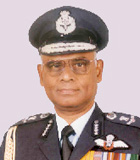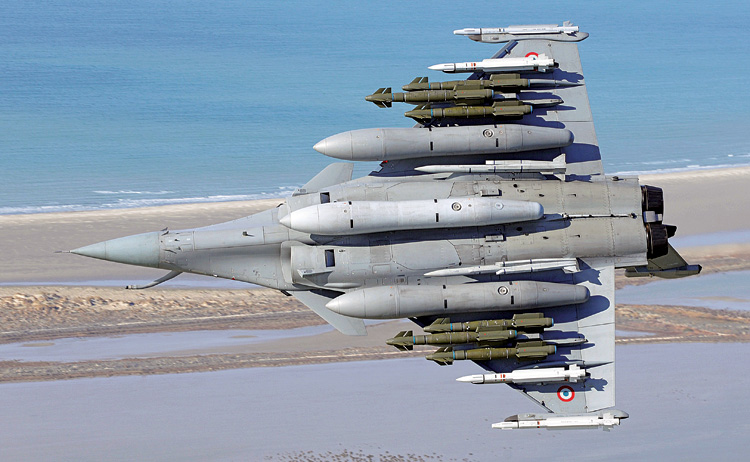INDIAN ARMED FORCES CHIEFS ON OUR RELENTLESS AND FOCUSED PUBLISHING EFFORTS

The insightful articles, inspiring narrations and analytical perspectives presented by the Editorial Team, establish an alluring connect with the reader. My compliments and best wishes to SP Guide Publications.

"Over the past 60 years, the growth of SP Guide Publications has mirrored the rising stature of Indian Navy. Its well-researched and informative magazines on Defence and Aerospace sector have served to shape an educated opinion of our military personnel, policy makers and the public alike. I wish SP's Publication team continued success, fair winds and following seas in all future endeavour!"

Since, its inception in 1964, SP Guide Publications has consistently demonstrated commitment to high-quality journalism in the aerospace and defence sectors, earning a well-deserved reputation as Asia's largest media house in this domain. I wish SP Guide Publications continued success in its pursuit of excellence.
IAF Deserves Rafale Don’t Hassle the Deal
There must be serious introspection on how the government and the opposition should debate defence acquisition in a constructive manner and arrive at consensus without blocking the process
 | By Air Chief Marshal S. Krishnaswamy (Retd) Former Chief of the Air Staff, IAF |

2019 is the election year in India and it is the time for rising political debates. A winning point could make a winning change in the outcome – or so it is believed. It does not matter what the subject is, but it is important to get traction. One could view the recent debates on the Rafale acquisition in this context. The government has decided to acquire 36 Rafale fighter jets directly from Dassault Aviation of France through an inter-governmental contract cancelling the decision made by the earlier government, the United Progressive Alliance (UPA) to acquire 126 of these. With less than a year to commence delivery of the 36 now on order, the opposition has dug out some controversies surrounding the deal. From discrediting the deal to questioning the Government and its motives for changing the terms of the deal from its original form, the public debate has taken an unpleasant turn. The opposition is well aware of the inability of the Government to publicly share the details of the contract due to the secrecy clauses present in the various inter-governmental agreements. In response, the Government has been strong in its reactions to these allegations. Sadly, this retaliatory and hostile form of political debate does not benefit anyone, least of all the nation. There is a serious worry on our ability to cope with the demands that may arise to secure our nation if the strength of the combat fleet in the Indian Air Force (IAF) gets depleted as was happening.
DEPLETION OF THE COMBAT FLEET OF THE IAF
Combat squadrons in the IAF have been depleting steadily due to the retirement of old aircraft fleets. Replacement was not forthcoming. The last of the MIG-21s that are still being flown, would retire shortly. The IAF is probably down to 31 squadrons from the authorised level of 42 and the strength is expected to go down further. Any new induction takes time to arrive and operationalise. A few SU-30MKI that are still to be produced would be delivered in a year or so. The Light Combat Aircraft (LCA) Tejas as an operational system is still evolving. The production rate of the LCA Tejas is very slow though attempts are being made to speed things up. Even if all these productions fructify, it would still not arrest the rate of depletion of combat Squadrons.
MEDIUM MULTI-ROLE COMBAT AIRCRAFT (MMRCA)
The Air Staff Requirement (ASR) for Medium Multi-Role Combat Aircraft (MMRCA) was finalised by the Air Head Quarters in 2008. Against this ASR, Dassault Aviation’s Rafale and the European military consortium Airbus Eurofighter Typhoon were shortlisted after evaluation that both met the ASR. The Rafale was selected in 2012 being the lowest bidder (L1). The agreement for a license production was nearly concluded for 126 aircraft in 2012 under the previous government. But, the deal got stuck when the Original Equipment Manufacturer (OEM) was reluctant to stand guarantee on the aircraft produced in India by Hindustan Aeronautics Limited (HAL). When the NDA government came to power in May 2014, the Rafale deal remained unsigned.
CONTRACT FOR 36 RAFALE
To overcome the hurdle and to meet urgent requirements, the IAF projected a minimal need for 36 aircraft to avoid a serious situation. This put the NDA government under pressure leading them to re-look the contract. They found that HAL estimated nearly three times more man-hours to produce the aircraft as compared to the production time by the OEM. This meant delays and higher costs. Besides, HAL would roll out only the basic aircraft. Weapons, maintenance support and spares support needed to be separately contracted. The government decided to work out a fresh agreement and purchase 36 aircraft directly as a package comprising missiles and weapons, external stores and improved radar and Electronic Warfare suite. Training systems, performance-based logistics support, enhanced period of maintenance support and full technical facilities at two bases of the IAF where the Rafale squadrons were planned to be located, were also part of this new deal. The package assured the quickest possible way to operationalise a new induction.
To overcome the hurdle and to meet urgent requirements, the IAF projected a minimal need for 36 aircraft to avoid a serious situation
The cost of 36 operational-ready aircraft including the comprehensive package, was negotiated and the deal was signed in 2016. The cost of these would obviously be much higher than that of the basic aircraft that was earlier considered for license production at HAL. If there are concerns regarding escalation of costs as per the new deal, it is possible for the Parliament to debate these in secrecy; but such details cannot become public, for reasons of inter-governmental relations as well as national security. The opposition is not keen to debate in secrecy since the ruling party has a majority in the Parliament that would have made it difficult to argue in equitable terms. Besides, the cost details, the standard-of-preparation (SOP) of Indian Rafale is sensitive and very different from those supplied to others including the French Air Force.
The Rafale deal of 2016 involves a 50 per cent offset of which 30 per cent is to be spent by Dassault for military aerospace R&D and 20 per cent for manufacturing components for the Rafale in India. The OEM (Dassault and their partners) could choose any Offset Partner in India from a list of over 100 companies, one of which is Reliance Defence. The Defence Research and Development Organisation (DRDO) is likely to benefit from the R&D offset to develop the Kaveri engine. It is likely that none of the 36 aircraft that are to be delivered to India between 2019 and 2022, would have parts produced by Indian offset partners since the time available for delivery is too short. The Indian offset production would supply spare parts for use in India and for export. Apart from the offset deal, Anil Ambani’s Reliance Group and Dassault Aviation formed a joint venture (JV) named Dassault Reliance Aviation Ltd (DRAL) with the Reliance Group having a 51 per cent stake in the JV. This JV is intended to make aero structures for Dassault’s Falcon 2000 civil aircraft and has the potential to make parts for the Rafale. Thales of France has also announced its intention to set up a JV with Reliance to produce avionics components for the Rafale.
Procurement of 36 aircraft was meant to meet the urgent needs of the IAF, but it would not solve the problem of fighter aircraft depletion. As the next step, a global Request for Information (RFI) was issued earlier this year for the licensed manufacture of 110 combat aircraft in India. This acquisition is being pursued.
SCRUTINY OF THE DEFENCE ACQUISITION PROCESS
The Public Accounts Committee (PAC) is a ‘watch-dog’, an eye at the national level, on how the government runs its business. It has been 30 years since the Chairperson of the PAC examined the Jaguar deal. Every induction in the IAF had gone through the scrutiny by national-level monitors such as the Comptroller and Auditor General of India (CAG), the Central Vigilance Commission (CVC) and other audit authorities. The CAG has the powers to audit budget, expenditure and performance of the Ministry of Defence (MOD) and the Defence Services. The CVC maintains vigilance against impropriety and has the powers to investigate independently. Major purchases go through pre-audit to bring out any glaring omissions or commissions. Like the Jaguar deal that was concluded as an outdated design, procurement of Mirage-2000 was severely criticised for having acquired an aircraft without weapons, which were procured subsequently at additional cost. The SU-30MKI project was criticised for serious delays and escalation of cost. Due corrections were made, the dust settled down and the inductions proceeded smoothly.
THE FINAL WORD
Debates have a necessary role to play in any democracy. But it must be done calmly, keeping a focus on national security. Severe criticisms that are politically motivated demoralises the bureaucracy and the military and have adverse effect on timely decisions. The overall accountability to the Nation and its people of all participants in such deals, must be ensured. There has got to be serious introspection on how the government and the opposition should debate defence acquisition in a constructive manner and arrive at consensus without blocking the process or causing delays.





